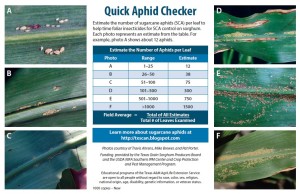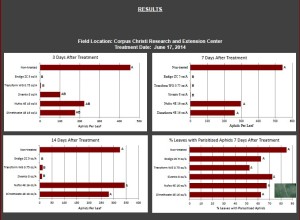 I have been out of town for a week, so unfortunately any observations are not my own. However, going by the number of phone calls I’ve received I’m certain many fields are above treatment thresholds at this time. I was asked to look at a crop of sorghum before leaving last week, and found a great looking sorghum crop. Adequate rainfall and warm weather have led to a good start for sorghum. The field I looked at had aphid populations of about 50 aphids per leaf. The experts say we tend to underestimate number per leaf. Current recommendations are to apply recommended chemicals when aphid counts are 100-250 per leaf. I began finding sugarcane aphids in May on Johnsongrass. Therefore, we have had much more time to build populations this year than in 2014 when they were first found in August in North Florida. Texas A&M Agrilife Extension has released a great tool in their Quick Aphid Checker to help us make accurate estimates of building populations.
I have been out of town for a week, so unfortunately any observations are not my own. However, going by the number of phone calls I’ve received I’m certain many fields are above treatment thresholds at this time. I was asked to look at a crop of sorghum before leaving last week, and found a great looking sorghum crop. Adequate rainfall and warm weather have led to a good start for sorghum. The field I looked at had aphid populations of about 50 aphids per leaf. The experts say we tend to underestimate number per leaf. Current recommendations are to apply recommended chemicals when aphid counts are 100-250 per leaf. I began finding sugarcane aphids in May on Johnsongrass. Therefore, we have had much more time to build populations this year than in 2014 when they were first found in August in North Florida. Texas A&M Agrilife Extension has released a great tool in their Quick Aphid Checker to help us make accurate estimates of building populations.
The phone calls I have received have not been about insect ID, but mostly about control options. I want to take an opportunity to clear up the situation with labeled chemicals and recommendations. Mostly, people are wondering, “What is going on with the Transform WG label we had last year?” I want to take a minute to clearly describe the situation. In the summer of 2014, a team including Florida Farm Bureau, Florida Department of Agriculture and Consumer Services, UF/IFAS Extension, and Dow worked together to obtain an Emergency Section 18 label for the use of Transform WG on sorghum in the absence of other suitable control methods. The Section 18 label was issued by the U.S. EPA and expired December 31. Subsequently, Bayer CropScience received a full Section 3 label for Sivanto in February 2015. With a suitable control method in Sivanto, this team had no grounds to pursue an emergency Section 18 Exemption for Transform WG in Florida in 2015. The team was told Dow is in process of acquiring a Section 3 label for Transform WG, but at this time it has not been granted by EPA. Farmers should realize excellent control with Sivanto,, like they saw with Transform WG last season. I have attached some work by Ahrens Et. al., conducted in 2014 showing the efficacy of Sivanto in 2014 trials (More information HERE). Those trials used the 8 oz rate.
Sivanto also has a Section 2ee label for reduced rates for control of Sugarcane Aphid in sorghum. Dr. David Buntin, UGA Extension Entomologist, tested Sivanto at the 3,5, and 7 oz rates in 2014 and his current recommendation is the 4 oz rate. This reduced rate will make control much more economical. Results last year showed complete crop failure in many cases where no chemical control was used. I encourage you to scout your sorghum and utilize current thresholds and treat accordingly. This may require more than one application.

